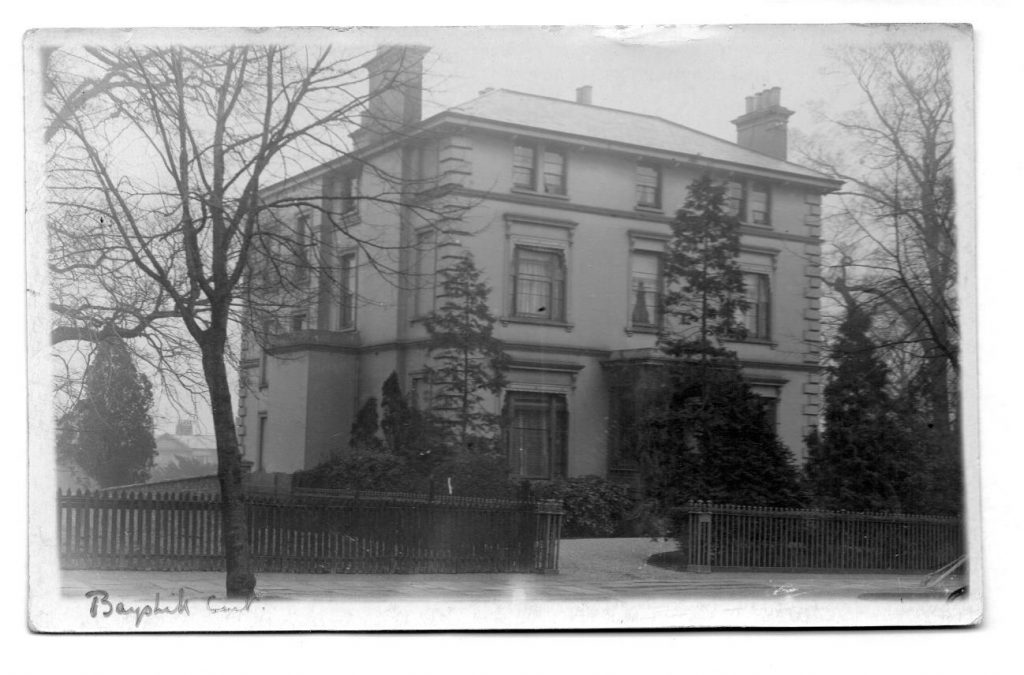“Christmas is Coming and the Boys are at The Rotunda”
Friday 13th and Monday 16th November 1914 Cheltenham was “invaded” by over 2,000 soldiers of the 9th and 10th Battalions of the Gloucestershire Regiment, billeted in the old, empty houses, mainly in Lansdown. Officers of the 9th Battalion were billeted at the Queen’s Hotel and 56 sergeants at 2, Queen’s Parade.
The soldiers of the 9th Battalion were fed from a field kitchen, providing useful practice for cooking at the Front. Aldershot ovens were based in the garden of Bayshill House in Parabola Road, which is now a Cheltenham Ladies College house.
 Bayshill House as it was in 1911.
Bayshill House as it was in 1911.The 10th Battalion installed their kitchens in a field at the back of Eckington House opposite the Lansdown Hotel.

Taking dinner to billets from field kitchens
The soldiers spent their days drilling, practising skirmishes on Cleeve and Leckhampton hills and digging trenches. One trench, dug for Cheltenham Corporation, was worked on by two hundred soldiers at a time. They built a 9 inch trunk main for improving water pressure in Leckhampton. The 4 foot by 2 foot trench, 1,600 yards long stretched from Sandford Road to Leckhampton Road and took eight days to complete over Christmas 1914. It must have been hard work with frost hardened ground and heavy snow on 28th December 1914.

Digging trenches in Sandford Road – 24th December 1914
Soldiers’ Welcome at The Rotunda
In spite of being provided with food, it wasn’t enough for hungry soldiers out marching or digging trenches all day. Within the week of the troops arrival, the combined churches of Cheltenham had set up a series of committees to provide a Soldiers’ Welcome at The Rotunda. In charge was the Commissariat was Mrs Wethered – ex Lady Mayoress of Cheltenham – and her extremely capable daughter Miss Mina Ricketts Wethered. They were ably supported by senior scouts of the Parish (12th Cheltenham) Boy Scouts under their able chef, the Scoutmaster, Mr Percy Crowther.
In the first week they kitchens at the Rotunda were providing 500 meals a day but by the fourth week this had mushroomed to 1,200 meals a day. For a halfpenny (22p equivalent today) the hungry soldier could buy a boiled beef sandwich or a cup of tea Two to three pennies would buy a meal of rabbit pie, cottage pie, fish and chips or sausage and mash.

Reverend Dwelly Rector of Cheltenham Back far left, far right Percy Crowther, front left Miss Wethered seated next to Mrs Wethered
The Echo of 11th December, four weeks after the opening, reported that the Soldiers’ Welcome was being “increasingly appreciated – reading, writing and attending to the wants of ‘Little Mary’”. The latter, apparently, meant the stomach! The amount of letter writing was enormous – many of the soldiers would have been away from home for the first time. Of the letter writers the reporter observed, “…watching them, you reflect on the differences in wit, in education or in the very circumstances which control the subject-matter of the letter.” In one day, one pound’s worth of postage stamps were sold amounting to 240 letters or 480 postcards. Every ten days, 20 reams of notepaper, 5,000 envelopes and 2,000 postcards were being supplied free of charge by the YMCA to the letter-writing soldiers at The Rotunda.
By Neela Mann from Cheltenham and the Great War
Leave a Reply